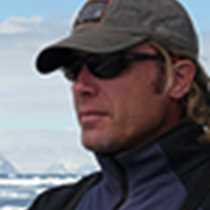Pond Island, Lake Eva
The pounding of our vessel through the night was akin to the low-beat cadence of a march-to-war kettledrum. After leaving the protection of Bartlett Cove in Glacier Bay National Park the previous evening, we had been exposed to the prevailing southerlies funneling northward up the gut of Chatham Strait. Plying through their teeth, our ship was slowed enough, that upon waking we were still in the middle of the channel and more than a couple of hours from our morning anchorage. On the surface, such a position may have appeared less than fortuitous. However, it was not a roadblock, just a delay. The time was still ours, and other possibilities loomed.
It was not long before they began to present themselves. A family of Sitka black-tailed deer daintily strode the shore at low tide along the eastern edge of Baranof Island searching for food. Farther south along the beach a large brown bear emerged from the alders. We watched as it began to stride the pebbled swath of open seashore. It quickly became clear she was a sow in the prime of life, as, one by one, a trio of cubs followed her out of the bush. This was no pedestrian sighting; a sow with three healthy cubs is relatively rare. She lumbered northwards down the beach, her progeny in tow. Along the forest edge, she frequently stopped to forage. Her three newborns wore a tangled path behind her, occasionally stopping to scrap with each other like kittens at play. At the beach’s end, she spun slow circles around a large patch of vegetation, periodically scraping at the ground and grazing. Her cubs continued to peruse the rocks and play without concern. In time, they moved back into the forest, disappearing into the temperate netherworld from which they came. Our ship moved on.
After breakfast, the National Geographic Sea Lion dropped anchor off Pond Island. A light rain was falling. Winds were slight, below a patchwork of gray clouds shot through with silver light. Zodiacs with cruisers, kayaks, and hikers fanned out in all directions, across land and over sea, to explore and to be surprised on our last day of communal exploration in SE Alaska.
Hikes yielded a cocktail of temperate rainforest flora – we had seen much of this already, but a few new plants were in the throes of the high-energy effort of reproduction. Flowers not seen yet, principally those of the muskeg – twin flower, lingonberry, and swamp gentian, to name a few – were pouring their reserves into producing the next generation of their kind. The results were a profusion of colors in a canopy barely higher than the tops of one’s shoes. From the watercourses hemmed in by beaver dams to a medium-sized lake morphing slowly to muskeg, we had to look down between knee-high grasses and sedges to witness the blanket of new growth. However, once we were focused on the world of the low and small, it was difficult to peel away. A kaleidoscope of life was springing anew just above the soil-hugging mat of sphagnum moss. Every patch the size of a National Geographic Atlas held a bevy of life and potential hours of study.
From the world of the small to the realm of the great and large, our morning’s exploration spanned the spectrum of SE Alaskan natural history wonders. This was no more evident than to those that went kayaking and Zodiac cruising. Theirs was a time not soon to be forgotten. Pond Island is flanked by numerous satellite islets, which shelter the waters near it. Though a light rain continued to fall, prevailing winds could not breach the barrier. The water was a mirror. From the liquid, black shapes began to emerge. Their size let us know immediately that they were humpback whales, and they were feeding right along the rocky shorelines. Repeatedly, a few whales would spread their diagnostically long pectoral flippers, like eagles on the wing, and fan them in gathering arcs, herding prey tighter and tighter. Then they would aim their rostrums skyward and open their great maws to consume the quarry. Our fleet of various shuttlecrafts was so close that the whales’ inner mouths were revealed in striking detail. Getting closer to the scene playing before us would have been to risk becoming Jonahs.
Our afternoon excursion to Lake Eva was essentially a recapitulation of much that we were exposed to during our sojourn through SE Alaska. Humpback whales continued to shadow the course to our anchorage, and then lazily peruse the protected waters near shore. Along our hikes, the telltale signs of mammalian habitation – prints, middens, and scat - were becoming easier to spot through our lens of experience. Most of the flora was now achingly familiar – enough so that most of us knew the names of the most conspicuous plant residents. This is a temperate rainforest, and it pulses with water and breathes through its vegetation. Lake Eva showcases all that is Southeast save for the glaciers, and the cool temperatures and snow-riddled mountains nearby let us all know that this land was carved and defined by them. They blanketed this land before, and they will do so again.




